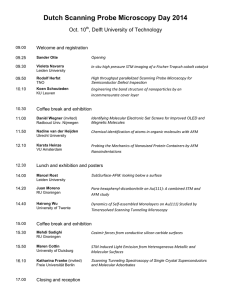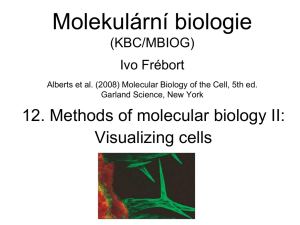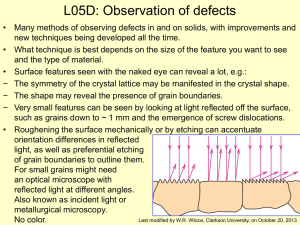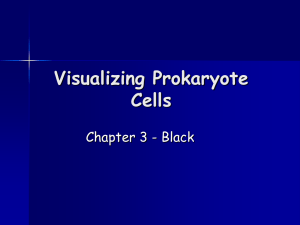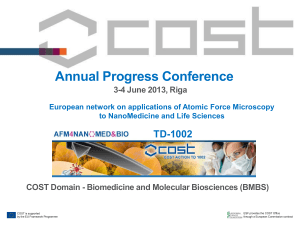Boldys_seminar_AFM
advertisement
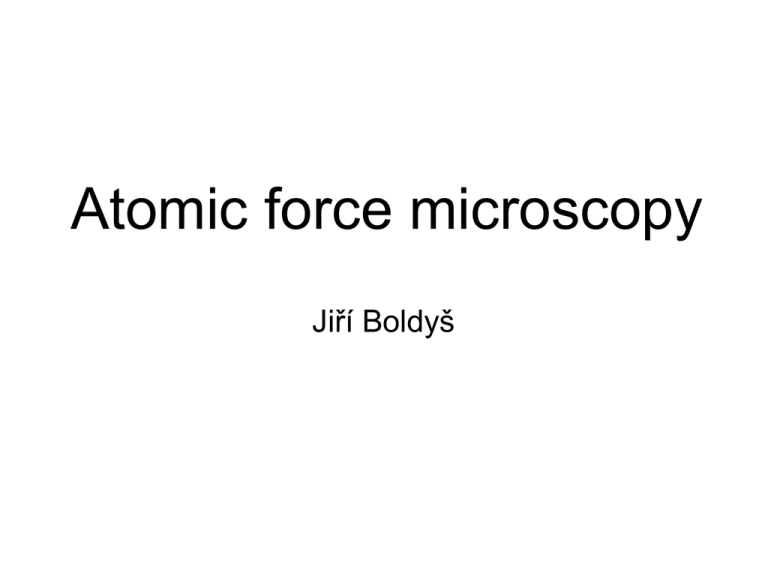
Atomic force microscopy Jiří Boldyš Outline Motivation Minisurvey of scanning probe microscopies Imaging principles Ideas about application of moment invariants Alternative reconstruction approach Image artifacts Classification of blur kernel symmetries n-fold circular symmetry (Cn symmetry) Dihedral symmetry (Dn) Radial symmetry Common blurs Atmospheric – radial symmetry Out-of-focus – radial, cyclic or dihedral symmetry Motion – central symmetry What invariants we have Model: g = f * h I(f)=I(g) Invariance x discriminability Invariants to kernels with Cn and Dn symmetry Potentially we can, we have not done that - arbitrary symmetry, arbitrary dimension Other potential applications Electron microscopy? – N-fold symmetrical correction elements Atomic force microscopy (AFM)? … But – Is there a convolution??? Scanning probe microscopy classification Scanning tunneling microscopy - STM Atomic force microscopy - AFM Electric force microscopy - EFM Magnetic force microscopy - MFM Scanning near-field optical microscopy - SNOM ... Scanning tunneling microscopy Mironov: Fundamentals of scanning probe microscopy, 2004 Scanning tunneling microscopy 1981 – Swiss scientists Gerd Binnig and Heinrich Rohrer Atomic resolution, simple 1986 – Nobel prize Chen: Introduction to scanning tunneling microscopy, 1993 Scanning tunneling microscopy The first demonstration of the atomic-resolution capability of STM – Si(111)-7x7, Binnig, Rohrer, Gerber, Weibel, 1983 Chen: Introduction to scanning tunneling microscopy, 1993 Scanning tunneling microscopy Chen: Introduction to scanning tunneling microscopy, 1993 Atomic force microscopy 1986, Binnig, Quate, Gerber 1989 – the first commercially available AFM Mironov: Fundamentals of scanning probe microscopy, 2004 Magnetic force microscopy Local magnetic properties AFM + tip covered by a layer of ferromagnetic material with specific magnetization Mironov: Fundamentals of scanning probe microscopy, 2004 Atomic force microscopy in detail Forces can be explained by e.g. van der Waals forces – approximated by Lennard-Jones potential Mironov: Fundamentals of scanning probe microscopy, 2004 Tip – sample force Energy of interaction Force – normal + lateral component Corresponds to deflections of an elastic cantilever Mironov: Fundamentals of scanning probe microscopy, 2004 STM vs. AFM STM Tunneling current drops off exponentially spatially confined to the frontmost atom of the tip and surface Distance dependence is monotonic simple feedback scheme Modest experimental means, excellent SNR AFM Force – short range + long range – less tractable as a feedback signal Not monotonic with distance Giessibl, Quate: Physics Today, 2006 Beam-bounce technique Mironov: Fundamentals of scanning probe microscopy, 2004 Feedback system Mironov: Fundamentals of scanning probe microscopy, 2004 Examples of cantilevers Si3N4, Si Different spring constants and resonant frequencies Images: Mironov, Fundamentals of scanning probe microscopy, 2004 Methods used to acquire images Contact vs. non-contact modes Contact modes attractive or repulsive Balance between atomic and elastic forces Small stiffness – high sensitivity, gentle to the sample Tip breakage, surface damages Not suitable for soft samples (biological) Constant force Constant average distance Mironov: Fundamentals of scanning probe microscopy, 2004 AFM image acquisition at constant force Mironov: Fundamentals of scanning probe microscopy, 2004 AFM image acquisition at average distance Mironov: Fundamentals of scanning probe microscopy, 2004 Force-distance curves – elastic interaction Mironov: Fundamentals of scanning probe microscopy, 2004 Force-distance curves – plastic interaction Mironov: Fundamentals of scanning probe microscopy, 2004 Forced oscillations of a cantilever Better for soft samples Reduce mechanical influence of the tip on the surface Possible to investigate more surface properties Piezo-vibrator Motion equation Mironov: Fundamentals of scanning probe microscopy, 2004 Forced oscillations of a cantilever Mironov: Fundamentals of scanning probe microscopy, 2004 Contactless mode of AFM cantilever oscillations Small forced oscillations amplitude – 1nm Close to surface – additional force Small oscillation around z0 Presence of a gradient in the tip-surface interaction force Additional shift of the amplitude and phase response curves Additional phase shift phase contrast AFM image Mironov: Fundamentals of scanning probe microscopy, 2004 Contactless mode of AFM cantilever oscillations Mironov: Fundamentals of scanning probe microscopy, 2004 Semi-contact mode of AFM cantilever oscillations Before – high sensitivity and stability feedback required In practice often semi-contact mode Excited near resonance frequency, amplitude 10-100nm Working point: Mironov: Fundamentals of scanning probe microscopy, 2004 Semi-contact mode of AFM cantilever oscillations Mironov: Fundamentals of scanning probe microscopy, 2004 Frequency modulation AFM Si(111) Reactive surface → Dynamic mode Ultrahigh vacuum FM-AFM – frequency modulation – introduced in 1991 First with commercial cantilevers with a limited range of spring constants Strong bonding energy Si-Si large amplitude of vibrations 34nm no atomic resolution small amplitudes stiff cantilevers dramatic improvement in spatial resolution Giessibl, Quate: Physics Today, 2006 From static to dynamic mode Static approach still in use Materials in liquids Tip subject to wear Large lateral forces Absolute force measurements are noisy Amplitude modulation AFM Driven near fundamental resonance frequency Less noise Sensing variations in amplitude Lateral forces minimized – broken contacts Giessibl, Quate: Physics Today, 2006 From static to dynamic mode Frequency modulation AFM Even less noisy Fixed amplitude Frequency as a feedback signal Lateral forces minimized – broken contacts Average tip-sample force gradient Frequency shift Further improvement – exploiting signal proportional to higher-order derivative – better spatial resolution And next – reconstruction using the frequency shift and higher-harmonic components of the cantilever vibrations Higher harm. can be viewed as a convolution of the nth-order derivative of the force with some weight function Giessibl, Quate: Physics Today, 2006 Revealing angular symmetry of chemical bonds Combined STM and FM AFM Angular dependence of chemical bonding forces between CO on copper surface Cu(111) and the terminal atom of metallic tip Forces depend also on angles between atoms Other opinions: feedback artifact or multiple-atom tips 3D force spectroscopy used Welker, Giessibl, Science, 2012 Revealing angular symmetry … Welker, Giessibl, Science, 2012 Silicon (111)-(7x7) surface Giessibl, Hembacher, Bielefeldt, Mannhart, Science, 2000 Non-expert ideas in the field of AFM Two ways of imaging – Tip imaging – Surface imaging Surface symmetry Tip symmetry Do we need to register (align) two blurred images, or one sharp and one blurred? Images with different class of blur – generates new mathematical task for us Registration of images blurred by kernels with different symmetry Example: – Tip imaging by surface with 4-fold (C4) symmetry … – Followed by tip imaging (the same one) by surface with 3-fold symmetry – Both kill different frequencies – together we might reconstruct them more easily and precisely Another example: – Scanning the same surface with 4-fold symmetrical and 3-fold symmetrical tip (due to crystallic structure) Is there any convolution? We are not sensing surface height (z-coordinate) - we are sensing force / potential energy Can potential energy be calculated as a 3D convolution? What we measure is a 2D surface in the 3D potential map Probe influences atom distribution We are sensing force through approx. linear dependence F(z) What if we do not measure pure force but rather frequency shift or higher order force derivatives? Mathematical morphology based reconstruction Intuitively degradation corresponds to the dilation operation in mathematical morphology Why not if the region where the forces are significant is << tip size Villarrubia, J. Res. Natl. Inst. Stand. Technol., 1997 Critical dimension AFM Higher throughput during quality control Not so ambitious resolution Dahlen et al., Veeco AFM imaging artifacts West, Starostina, Pacific Nanotechnology, Inc. AFM imaging artifacts West, Starostina, Pacific Nanotechnology, Inc. AFM imaging artifacts West, Starostina, Pacific Nanotechnology, Inc. AFM imaging artifacts West, Starostina, Pacific Nanotechnology, Inc. AFM imaging artifacts Mates, Summer school of SPM microscopy, 2007 Thank you! Recommended reading: Giessibl, Quate: Physics Today, Exploring the nanoworld with atomic force microscopy, 2006
